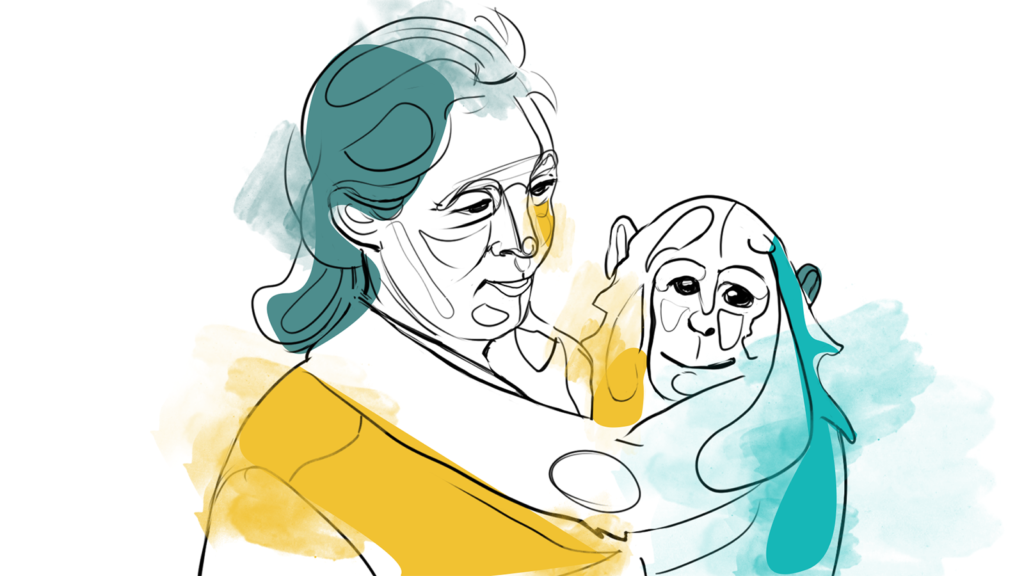Scientist Jane Goodall always watched the world around her. As a child, she would spend hours watching jumping spiders and keep all kinds of pets. She also gave her parents quite a scare when she went missing as a child. But her parents eventually found her in the henhouse observing the chickens. Jane just wanted to know how they laid their eggs.
Goodall’s curiosity, patience, and powerful observation skills ultimately led her to Tanzania’s Gombe Stream Game Reserve. She established relationships with chimpanzees in the reserve and watched them search for food, find mates, and tend to their babies.
She wrote the book The Chimpanzees of Gombe: Patterns of Behavior in 1986 and completely upended our understanding of chimpanzees’ behavior. Goodall eventually left the field to advocate for captive chimpanzees and sustainable development. There is a lot we can learn from this keen observationist, prolific writer, and environmental activist.
This article is part of the Brilliant Thinkers series, which explores the thought processes, working habits, and decision-making principles applied by intellectuals who profoundly impacted the world with their discoveries and the way they challenged the status quo.
Jane Goodall’s thinking strategies
Jane Goodall had a deep understanding of the importance of immersing ourselves in the world around us and the value of taking our time. She also showed trust in her research when faced with rebuttal from fellow scientists. Here are three strategies she applied throughout her extraordinary life and career.
1. Immersing yourself in the world. Like other young women in the 1950s, Goodall began her career as a secretary. So how did she become a renowned scientist? While working as a secretary in Nairobi, Goodall met paleontologist and anthropologist Louis Leakey. Leakey was so impressed by Goodall’s knowledge and understanding of the natural world that he brought her on as a researcher to study chimpanzees in Tanzania. Goodall eventually earned her Ph.D. in Ethology in 1965, becoming one of the only people to do so without a Bachelor’s degree. She is proof that not all groundbreaking scientists start in a lab; there is much to be learned just by looking at the world around us.
2. Taking your time. It took 25 years for Goodall to publish her definitive book on chimpanzees’ behavior. Each discovery she made was the result of patiently looking for patterns. For instance, Goodall once observed a chimp using a blade of grass to pull termites from a mound. If she stopped there, she might have noted that one chimp used grass to feed himself. But the next day, Goodall witnessed the same chimp pull leaves off a twig to get at the termites. The chimp made a tool. That novel discovery would not have happened without a lot of time spent in the field and several focused observations.
3. Having the courage of your evidence-based convictions. In academia, Goodall faced challenges with men who belittled her work or did not accept her findings. In a 2014 interview, Goodall explained that these critiques from men did not matter because she was confident in her work and results. She said: “My mother always taught us that if people don’t agree with you, the important thing is to listen to them. But if you’ve listened to them carefully and you still think that you’re right, then you must have the courage of your convictions.”
How to think like Jane Goodall
The outside world can become invisible when we focus on solving specific problems. For example, it is very common for startups to build solutions in search of a problem. To think like Jane Goodall, pick your head up and look around you. Do you see any patterns? How are people navigating the world? You can learn a lot from pure observation.
Another important ingredient in Jane’s thinking toolkit is patience. Remember, her definitive book on chimpanzee behavior took 25 years to publish. It takes time to learn new things and develop mastery of a new skill, topic, or process. Give yourself grace when you are still in the knowledge-building phase.
Finally, stand up for yourself, especially when facts and data are on your side. Follow the advice from Jane’s mother. If someone disagrees with you, listen to their reasoning. After listening, if you believe you are right, be willing to say so. Be especially wary of those who seem to disagree with you based on factors that have nothing to do with your actual work.
Jane Goodall’s patience, curiosity, and confidence made her one of the most influential scientists of our time. The lessons we can learn from her remarkable career should inspire us to be more present in the world around us. Goodall’s life also highlights the rewards that come with taking our time and the benefits of standing firm in our beliefs. What can you do today to follow in her footsteps?

